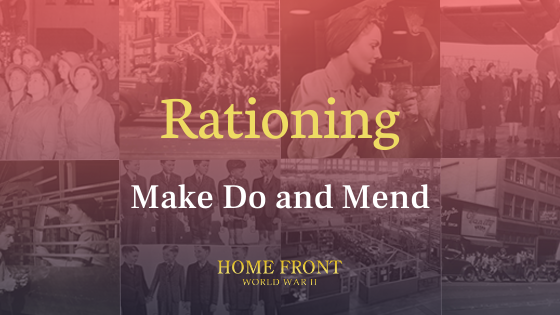Make Do and Mend
Rationing during wartime included more than just food. Clothing was also rationed as fabric and industrial capacity was needed for war material. To encourage people to save and reuse clothing and fabrics or materials they already had, the British government launched the Make Do and Mend campaign in the early 1940s. Canadians, too, were encouraged to reuse, mend, and recycle clothing to aid the war effort. Children were a part of this effort and were taught how to make and mend clothing, but it was still mostly women who took on this responsibility.
One way that people made their clothes last longer was mending old clothes instead of getting rid of them. This required skilled sewers and people were encouraged to improve their sewing skills. Even boys were taught how to sew! If old clothes could not be mended, or a new garment was needed, it was also common practice to make something new out of an old piece; this, too, required skilled sewers. Women also took items like curtains, table cloths, blankets, and men’s clothing and repurposed them into new dresses, skirts, and jackets.
Along with improving sewing skills, knitting became a popular and important pastime during the war years. Knitted clothing could be used at home or sent abroad to comfort soldiers serving overseas. Children were taught how to knit in schools, including the boys. The Junior Red Cross had a knitting club as well that collected pieces to send to soldiers.
YOUNG LADY HAVING GLAIDE LIQUID HOSIERY APPLIED TO HER LEGS IN A STORE, BRISBANE, SEPTEMBER 1941. PHOTO COURTESY OF THE STATE LIBRARY OF QUEENSLAND
During wartime, nylon was diverted from public consumption to be used in parachutes and flak jackets. Consequently, nylon stockings were in short supply. Sometimes pairs of nylons could be obtained on the black market, but only at exorbitant prices. Many women resorted to painting their bare legs with make-up to imitate the look of hose. Some companies started selling “liquid stockings.” Women sometimes even used gravy to paint their legs during nylon shortages! After applying make-up or gravy, the look was completed with a line drawn up the back of the leg with an eyeliner pencil to mimic the look of the seam.
World War II was a total war, which meant that everyone, including civilians, was affected by the conflict. Many Canadians served overseas, and those at home went in droves to new wartime industries. However, Canadians felt the effects of war in other ways as well. Every Canadian, regardless if they worked in a wartime industry or had a loved one overseas, was impacted by rationing. During the war, supplies like food, fabric, metals, and rubber, were in high demand for war material or feeding soldiers and allies. For example, gasoline was rationed and the purchase of gasoline required coupons from the ration booklet. This blog series will focus on rationed goods, how Canadians supplemented their personal food sources, and how Canada organized supplies to provide relief to their allies.


